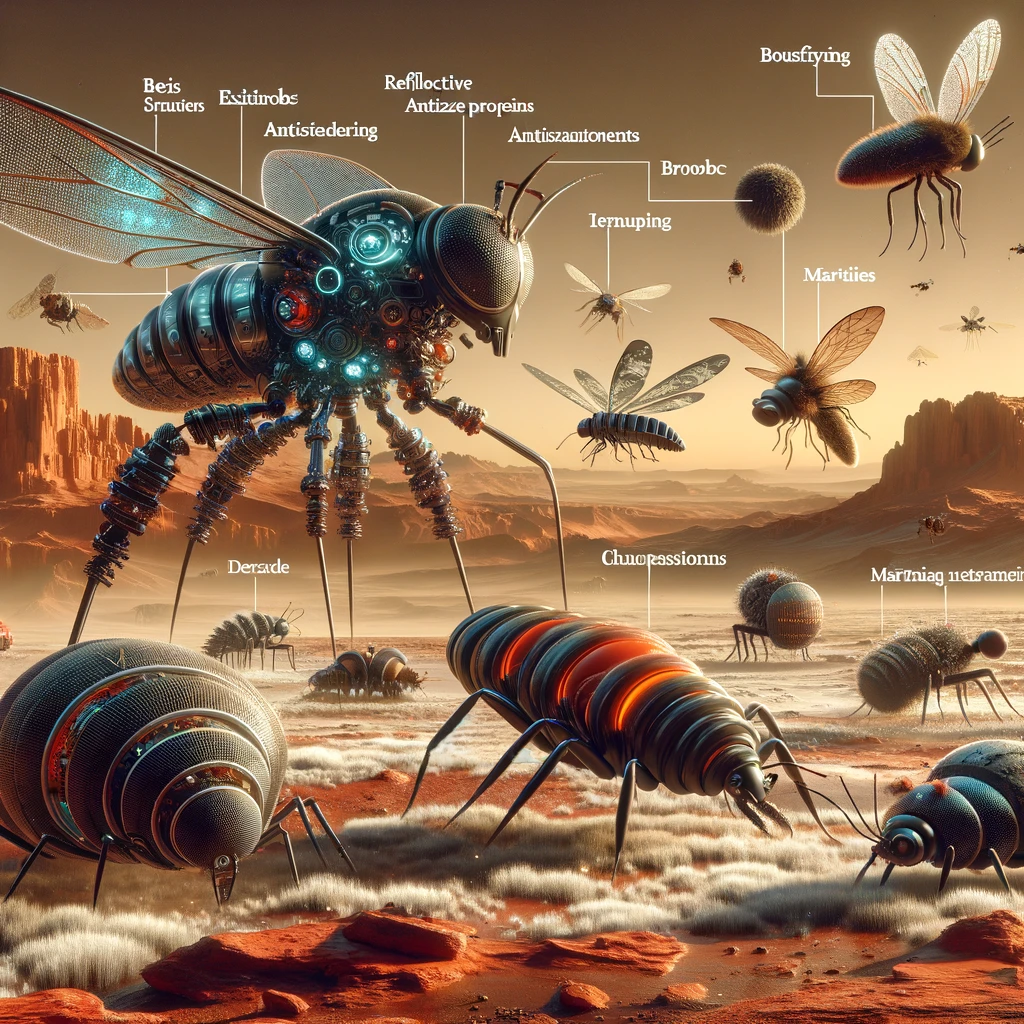
On a hypothetical exploration of Mars, where the atmosphere and environment differ drastically from Earth, the introduction of specialized insects could play a pivotal role in the terraforming process and ecological development. Imagining such an ecosystem involves considering various aspects including adaptation to extremes, life cycles, and interactions within the environment.
Insects, due to their adaptability and resilience, could be engineered to survive in the harsh Martian conditions, characterized by high radiation, low temperatures, and thin atmosphere. These conditions necessitate a “winterized” approach to their design, perhaps through genetic modifications that enable them to withstand sub-zero temperatures and high heat scenarios alike. This could involve the integration of antifreeze proteins to prevent ice formation in their tissues, and reflective exoskeletons to protect against solar radiation and maintain body heat.
The Martian environment’s extremes would require these insects to be efficient in every aspect of their existence. Efficiency in energy use, reproduction, and resource management would be key for survival where resources are scarce. Bioengineering could lead these insects to develop auxotrophic capabilities, relying on minimal external nutrients by synthesizing necessary compounds internally from the sparse Martian materials. Such adaptations would allow them to exist with minimal sustenance while contributing to ecological building and nutrient cycling.
Life cycles on Mars would likely differ significantly from those on Earth. Given the longer Martian year and the intense conditions, insects might evolve longer developmental periods or, conversely, extremely accelerated life cycles to take advantage of short periods of optimal conditions. These insects could become central to the creation of a sustainable ecosystem, decomposing organic matter and recycling nutrients.
As scavengers, these Martian insects would break down dead organic material and waste, facilitating nutrient recycling in a nascent Martian biosphere. This role would be crucial in building soil and supporting plant life, gradually transforming the Martian ground for agriculture and habitation.
Wind on Mars, with its notorious dust storms, would pose a significant challenge yet also offer a mode of transportation. Insects could be designed to harness the power of the wind for dispersal across the terrain, aiding in the spread of microbial life and organic material, thus fostering widespread ecological development.
Moreover, the introduction of parasitic and symbiotic relationships could stimulate biodiversity. Parasitic insects could help control the populations of other species, preventing any one group from overwhelming the budding ecosystem. On the other hand, mutualistic relationships could evolve, where insects aid in pollination or protection of other life forms, enhancing survival rates across species.
However, the risk of contagion – the rapid spread of disease or maladaptive genes – would be significant in such a tightly-knit ecosystem. Bioengineers would need to implement robust measures to prevent outbreaks that could devastate the population. Monitoring and rapid response systems could be integrated into the insects, enabling real-time adjustments to genetic expressions or behaviors in response to environmental feedback.
Further complicating the Martian insect ecosystem would be the concept of auxotrophs, which could be engineered to be dependent on specific nutrients that must be manually added to the environment. This dependency would serve as a control mechanism, preventing these insects from becoming invasive species should they somehow return to Earth or spread uncontrollably on Mars.
The efficiency of such a system hinges not only on the biological and ecological aspects but also on the energy and resource inputs required to sustain it. The development and maintenance of these life forms would need to be meticulously planned to ensure that the energy cost does not outweigh the ecological benefits.
In essence, the introduction of bioengineered insects to Mars presents a fascinating, albeit speculative, avenue for terraforming and ecological development. These insects, adapted to the extreme conditions and capable of contributing significantly to the Martian biosphere, could be instrumental in making Mars more habitable for future human missions. Such an endeavor would blend the cutting-edge of genetic engineering, ecological planning, and planetary science, marking a bold step in human interplanetary exploration.
Concept art depicting bio-engineered insects designed for Mars terraforming, adapted to the extreme conditions of the Martian environment.